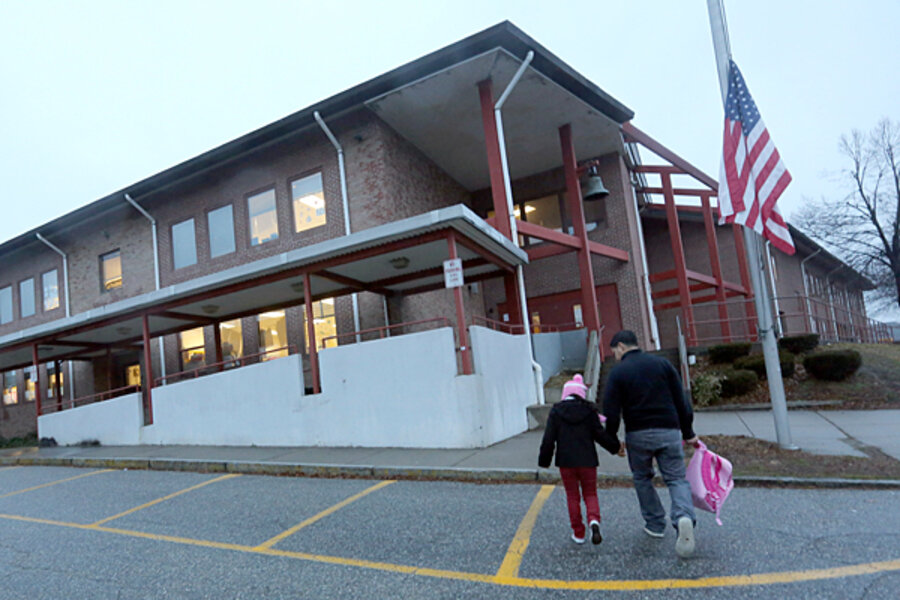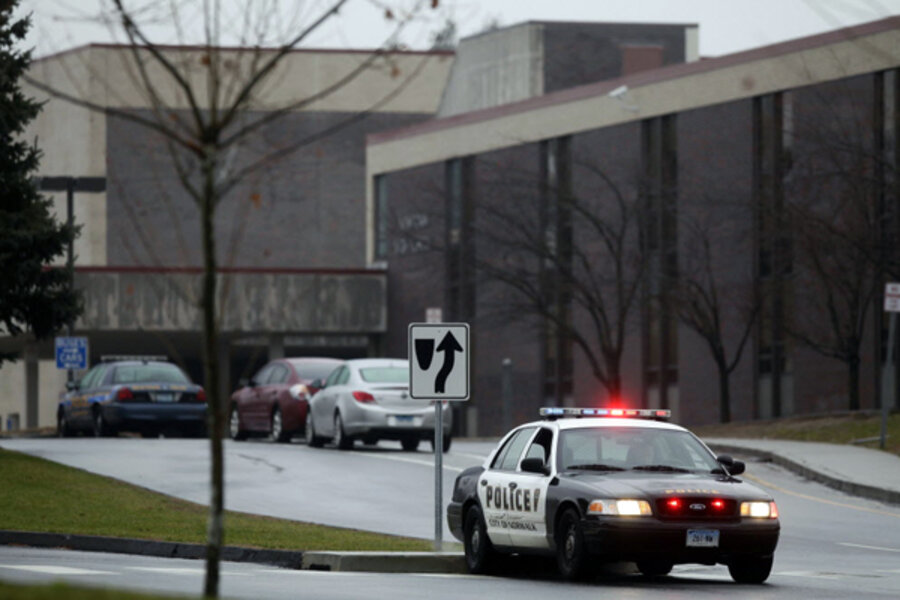School safety: learning from what Sandy Hook did right
Loading...
| Boulder, Colo.
Police are increasing their presence at elementary and high schools across the United States this week.
Districts from Little Rock, Ark.; to Wooster, Ohio; to Tucson, Ariz., are reviewing security measures, planning future “lockdown” drills, and sending home reassuring letters to parents.
One small district in western Pennsylvania, whose board had previously voted to eventually arm police in schools, got a court order over the weekend to arm an officer in each of its schools by Monday. The superintendent says that he expects an armed officer to be in each of its 14 schools from now on.
But even as superintendents and principals around the country scramble to update safety plans and investigate new options, they also face a grim reality: Sandy Hook Elementary School in Newtown, Conn., did pretty much everything right.
The school had a new buzzer and camera system, installed this year, that visitors were required to go through to be admitted. It had lockdown procedures and safety drills, as well as a good relationship with local first responders.
And yet a gunman was still able to shoot his way into the school and kill 26 people, 20 of them children, before turning his gun on himself.
“This is simply a reminder of how vulnerable schools continue to be,” says Ronald Stephens, executive director of the National School Safety Center in Westlake Village, Calif. “Despite some of our best efforts at making schools safe, when you’re dealing with a committed assailant it’s extremely difficult to stop [the attack].”
That said, Mr. Stephens and others agree that there’s still a lot schools can do to be safer – many of them the procedures Sandy Hook already had in place. And, they note, it’s possible that the loss of life at Sandy Hook would have been even worse had some of those procedures not been in place.
“Instead of asking, ‘Did nothing work?,’ another way of looking at it is, ‘Did some things work that could have prevented an even greater loss of life?’ ” says Kenneth Trump, president of National School Safety and Security Services in Cleveland.
Even the brief delay that resulted when the gunman had to shoot his way into the school rather than simply walking in may have helped, he says. And there are reports of teachers who instituted lockdown procedures, got kids out of hallways, and ran to try to stop the shooter, all of which may have saved some lives. And the response by law enforcement was very rapid.
“There were a number of things that were best practices,” Mr. Trump says. “Sadly, they did not result in the desired outcome, but we have to ask.... Could the situation have been even worse?”
For schools asking themselves what to do in the wake of the Newtown tragedy, he advocates “focusing on the fundamentals” rather than trying to come up with brand-new safety measures: controlling access to the building; having a crisis plan in place that is regularly reviewed; training staff on that plan; working with local police; cultivating the relationship with students; and retaining a strong support staff of counselors, psychologists, and school resource officers, all of whom can help significantly with prevention.
“We need to be talking as much about mental detectors as metal detectors in this conversation,” Trump says.
Stephens agrees, and he also emphasizes the importance of identifying all staff members as part of a school’s emergency response team. “We’re accustomed to contracting out for everything,” he says, “but the security and safety team is the entire staff.”
Training maintenance and custodial people and giving them a two-way radio connection with the central office can help, he says, because they’re often the ones who first spot a shooter. And simply holding fire drills – which may be less traumatizing and more tolerable to young students than, say, a “shooter drill” – can reinforce necessary safety principles.
But part of the difficulty in making schools safe, Stephens notes, is that schools are designed – intentionally – with openness in mind.
“There’s a longtime philosophy of schools that we provide the least restrictive environment,” he says, referring to a standard for educating special-needs students. “It’s talking about how we mainstream students for academic success, but it’s also a level of reality here that schools aren’t designed as fortresses to be defended. They’re designed as open places of public access.”
Reviewing safety procedures and stepping up precautions makes sense, Stephens says, noting that many schools don’t even have the common-sense procedures in place that Sandy Hook did. But, he says, it’s important to guard against overreacting in the immediacy of a crisis and to encourage schools to use the concept of “reasonableness” as their yardstick.
“How do we strike a balance between creating a safe and welcoming campus without turning it into an armed camp?” he asks. “How do we embrace principles of learning and child development, without being so intrusive in our response that we make it difficult to learn?”
Trump also hopes that the Newtown tragedy helps reverse the trend in recent years toward eliminating safety personnel, school resource officers, counselors and psychologists, and federal grants aimed at helping schools with security.
“It’s a competition for time and money, and school safety has been losing on both counts,” he says.
Over the past decade, Trump says, nearly every federal program for school safety has been reduced or eliminated, including the Readiness and Emergency Management for Schools grant, which used to dispense between $25 million and $29 million a year, as well as the Secure Our Schools grant. The Office of Safe and Drug-Free Schools was downsized and renamed the Office of Safe and Healthy Students, and its priorities were shifted, he says.
Restoring some of those things, he says, could go a long way toward helping schools find the resources they need to be safer.
“Do we need a police officer in every single building?” asks Trump. “As a parent, I would say yes, that’s ideal, and I’d like one attached to my child every day. But in terms of implementation, we have to look at where’s a happy balance.”







